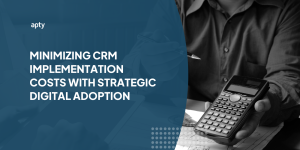In an environment where data increasingly drives decision-making, the role of Customer Relationship Management (CRM) systems becomes pivotal for Sales VPs. These tools are not just repositories of customer information but are integral to strategic planning, especially regarding sales forecasting. Elevating Customer Relationship Management reporting can transform sales forecasting, offering Sales VPs insights into optimizing their strategies for better outcomes.
When fully leveraged, CRM systems provide a foundation for accurate sales forecasting. This process is crucial for anticipating market trends, aligning sales strategies, and ensuring the sales team’s efforts are directed toward achievable targets. However, the effectiveness of sales forecasting is heavily dependent on the adoption and integration of Customer Relationship Management within the sales process. By focusing on enhancing Customer Relationship Management adoption, sales forecasting becomes not only more accurate but also a pivotal tool for strategic decision-making.
This journey through CRM reporting enhancement covers various facets, from increasing CRM adoption and automating workflows to securing data and leveraging Customer Relationship Management for customer retention. Each plays a vital role in ensuring that sales forecasting is accurate and actionable.
The Role of Sales Forecasting in CRM
Sales forecasting in Customer Relationship Management is more than a predictive metric; it’s a strategic compass guiding sales teams toward their targets. At its core, sales forecasting enables Sales VPs to predict revenue over a given period, providing invaluable insights into future sales potential. This foresight is crucial for planning, from setting realistic sales goals to managing inventory and allocating resources efficiently.
Sales forecasting accuracy directly influences a company’s ability to anticipate market demands, tailor its sales approach, and, ultimately, secure a competitive edge. CRM tools are central in gathering and analyzing data on past sales, customer interactions, and market trends. The integration of Customer Relationship Management sales force automation further refines this forecasting by automating data collection and analysis, leading to more accurate predictions.
However, the effectiveness of sales forecasting hinges on CRM adoption and the seamless integration of digital adoption CRM strategies. When sales teams fully engage with their CRM system, the data becomes richer and the insights more accurate. Workflow automation in Customer Relationship Management can also significantly impact sales forecasting by streamlining sales processes and ensuring that the sales pipeline is accurately reflected in the forecast.

Furthermore, CRM systems contribute to enhanced customer retention strategies. Understanding the link between customer retention and sales performance is vital, as retaining customers often leads to repeat sales and referrals, which should be factored into sales forecasts. The importance of customer retention in CRM cannot be overstated, as it directly impacts revenue and long-term business growth.
Security is another cornerstone of effective sales forecasting within CRM systems. CRM data security ensures that the sensitive information used to predict sales trends is protected against breaches, maintaining the integrity of the forecasting process.
Sales forecasting in CRM is a multifaceted tool that extends beyond mere prediction. It’s about understanding the market, optimizing sales strategies, and ensuring every decision is data-driven. By focusing on CRM adoption, integrating advanced CRM functionalities like sales force automation, and emphasizing customer retention, Sales VPs can turn sales forecasting into a strategic asset that drives the company forward.
Delve More: Simplifying the Complexities of CRM Training: A DAP’s Role in Sales Operations
The Impact of CRM Adoption on Sales Forecasting

Adopting CRM systems is a game-changer for sales forecasting, serving as a critical determinant of its success. When Sales VPs and their teams fully embrace CRM platforms, the depth and quality of insights available for forecasting improve dramatically. This section explores the profound impact that CRM adoption has on the accuracy and utility of sales forecasting, underlining why it’s indispensable for achieving competitive advantage and strategic excellence.
Enhancing Data Quality and Accuracy
CRM adoption ensures that every interaction and transaction is captured, offering a comprehensive view of the sales landscape. This data richness is fundamental to sales forecasting, as it provides a detailed historical record from which predictive models can derive more accurate forecasts. When sales teams are fully engaged with their CRM, they contribute to a data ecosystem that’s both broad and deep, allowing for nuanced analysis of trends, patterns, and customer behaviors.
Streamlining Sales Processes through CRM Integration
Integrating CRM into daily sales processes goes beyond mere data entry; it involves tailoring the CRM’s capabilities to the unique workflows and needs of the sales team. This alignment between sales processes and CRM functionality increases CRM adoption and ensures that sales forecasting is based on the most relevant and up-to-date information. Workflow automation in CRM, for example, can eliminate manual data entry errors and free up sales reps to focus on relationship-building and strategic planning, thereby improving the overall quality of sales forecasts.
CRM as a Catalyst for Strategic Decision-Making
CRM adoption impacts sales forecasting by transforming it into a strategic tool for decision-making. With accurate sales forecasts, Sales VPs can make informed decisions about resource allocation, market expansion, and sales strategies. This strategic advantage is only possible when the CRM system is fully utilized and integrated into the sales strategy, ensuring that forecasts are based on comprehensive and current data.
Fostering a Culture of Data-Driven Decision Making
Increasing CRM adoption fosters a culture where decisions are based on data rather than intuition. This cultural shift is critical for organizations that leverage sales forecasting as a strategic asset. By encouraging sales teams to rely on CRM data for insights and forecasts, companies can ensure their sales strategies are grounded in reality and poised for success.
The Role of CRM in Customer Retention and Sales Forecasting
CRM systems play a pivotal role in customer retention, which, in turn, significantly impacts sales forecasting. Understanding customer needs, preferences, and behaviors through CRM data allows for more accurate future sales predictions, especially from repeat business and referrals. The importance of customer retention in CRM is thus twofold: it directly influences revenue and enhances the precision of sales forecasts.
The impact of CRM adoption on sales forecasting cannot be overstated. It’s the bedrock upon which accurate, reliable, and strategic sales forecasting is built. By prioritizing CRM adoption and integration, Sales VPs can unlock the full potential of their CRM systems, turning sales forecasting from a routine task into a strategic advantage that drives growth and success.
Read More: 5 CRM Implementation Failures and How to Avoid Them
6 Strategies to Increase CRM Adoption for Enhanced Sales Forecasting
Achieving high CRM adoption rates within sales teams is essential for harnessing the full potential of sales forecasting. This section provides actionable strategies to encourage the effective use of CRM systems, ensuring that sales forecasting becomes a precise and strategic tool for decision-making. Organizations can significantly improve their sales forecasting capabilities by focusing on CRM adoption, digital adoption in CRM, and workflow automation in CRM.

Tailor CRM to Sales Team Needs
One of the most effective strategies to increase CRM adoption is to customize the CRM system to align with the specific needs and workflows of the sales team. This customization can involve configuring the user interface for more straightforward navigation, automating routine tasks, and ensuring that the CRM software integrates seamlessly with other tools used by the sales team. By making the CRM system more relevant and user-friendly, organizations can encourage their sales teams to use it more consistently and effectively.
Provide Comprehensive Training and Support
Training and support are crucial for successful CRM adoption. Organizations should offer comprehensive training sessions that cover not only the basic functionalities of the CRM system but also advanced features that can aid in sales forecasting. This training should be ongoing to accommodate updates to the CRM system and continuously improve the sales team’s skills. Additionally, providing a support system for answering questions and troubleshooting issues can help alleviate frustrations that may hinder using the CRM.
Demonstrate the Value of CRM
To increase CRM adoption, it’s important to demonstrate the value it brings to the sales process. This can be achieved by showcasing success stories and real-life examples of CRM, which has improved sales forecasting and overall business outcomes. Highlighting specific features that can save time, generate leads, and enhance customer relationships can motivate the sales team to embrace the CRM system fully.
Foster a Culture of Collaboration
Encouraging a culture of collaboration can significantly impact CRM adoption rates. When sales teams see the CRM as a tool for sharing insights, data, and successes, they are more likely to contribute to and utilize the system. Sharing best practices, tips, and tricks among team members can also enhance the overall effectiveness of the CRM and its impact on sales forecasting.
Leverage CRM for Customer Retention
Integrating customer retention strategies into the CRM system can enhance its value and adoption. By using CRM data to understand customer behavior, preferences, and feedback, sales teams can tailor their approaches to improve customer satisfaction and loyalty. This not only supports the goal of customer retention but also provides valuable data that can be used to refine sales forecasts.
Ensure Data Security
Finally, ensuring the security of CRM data is imperative for maintaining trust in the system. Implementing robust data security measures and regularly educating the sales team on best practices for data protection can alleviate concerns about data breaches and encourage more consistent use of the CRM system.
Increasing CRM adoption requires a multifaceted approach that includes customization, training, demonstrating value, fostering collaboration, focusing on customer retention, and ensuring data security. By implementing these strategies, organizations can maximize the benefits of their CRM systems, leading to more accurate and effective sales forecasting.
The Evolution of CRM Workflow Automation and Its Benefits
As the digital landscape matures, CRM systems have evolved from simple contact management tools to sophisticated platforms capable of automating complex sales processes. This evolution marks a significant leap in how sales teams manage their workflows and forecast sales. The advent of workflow automation in CRM systems has brought about a transformation that streamlines operations and significantly enhances sales forecasting accuracy.
Streamlining Sales Processes
CRM workflow automation simplifies and accelerates numerous sales tasks, from lead generation to closing deals. By automating repetitive tasks, sales teams can focus more on building relationships and strategizing rather than getting bogged down in administrative work. This efficiency gain boosts productivity and ensures that the sales pipeline is always up-to-date, providing a clear and accurate foundation for sales forecasting.
Learn More: 4 Simple ways to increase your CRM Productivity
Enhancing Data Accuracy and Real-Time Insights
One of the most significant benefits of CRM workflow automation is its impact on data accuracy. With automated data entry and updates, the chances of human error are greatly reduced, ensuring that the sales forecast is based on reliable data. Moreover, real-time insights into customer interactions and sales progress allow Sales VPs to make informed decisions swiftly, adapting strategies to market changes.

Facilitating Better Customer Engagement and Retention
Workflow automation extends beyond internal processes to touch on customer engagement and retention strategies. Automated follow-ups, personalized communication, and timely responses to customer queries improve the customer experience and foster loyalty. This heightened level of engagement contributes to more accurate sales forecasting by providing insights into customer behavior and potential sales opportunities.
Empowering Sales Teams with Advanced Tools
Integrating advanced analytics and artificial intelligence with CRM workflow automation equips sales teams with powerful tools for predictive sales forecasting. These technologies can analyze vast amounts of data to identify trends, predict customer needs, and suggest optimal sales actions. This capability allows Sales VPs to anticipate market demands more accurately and tailor their strategies for maximum impact.
Supporting Strategic Decision-Making
CRM workflow automation supports strategic decision-making by providing a holistic view of the sales operation. Sales VPs can leverage automated reports and dashboards to assess performance against targets, analyze sales trends, and identify areas for improvement. This comprehensive overview enables more strategic planning and resource allocation, ensuring that efforts are focused where they will yield the best returns.
The evolution of CRM workflow automation represents a paradigm shift in sales management, offering a pathway to more efficient, accurate, and strategic sales operations. By embracing these technologies, organizations can enhance sales forecasting, drive productivity, and achieve a competitive advantage in the marketplace. The benefits of workflow automation in CRM are clear:
- Streamlined processes
- Accurate data for forecasting
- Improved customer engagement
- Advanced analytical tools for predictive forecasting
- Support for strategic decision-making
Learn More: Mastering Multi-Channel Selling Through DAP-Enabled CRM
CRM and Customer Retention: A Vital Link
In the competitive realm of sales and marketing, CRM (Customer Relationship Management) systems emerge as pivotal tools for cultivating and sustaining customer relationships. The significance of CRM extends beyond mere data collection, serving as the cornerstone of effective customer retention strategies. This section delves into the integral role of CRM in customer retention and its consequent impact on sales forecasting and business success.
Fostering Customer Loyalty through Personalized Engagement
CRM systems excel in gathering detailed customer data, from purchase history to personal preferences. This wealth of information enables sales teams to tailor their outreach and communication, offering personalized experiences that resonate with customers. Personalized engagement, facilitated by CRM, strengthens customer loyalty, increasing the likelihood of repeat business and referrals, which are crucial for accurate sales forecasting and long-term revenue growth.
Leveraging CRM Data for Insightful Customer Analysis
The data housed in CRM systems provides invaluable insights into customer behavior and preferences. Sales and marketing teams can analyze this data to identify trends, predict customer needs, and adjust their strategies accordingly. This proactive approach to customer retention, powered by CRM analytics, enhances customer satisfaction and informs more precise sales forecasting by anticipating customer actions and potential sales outcomes.

Enhancing Customer Service and Support
CRM platforms play a crucial role in improving customer service and support. With access to comprehensive customer histories and preferences, service teams can address inquiries and resolve issues more effectively and efficiently. High-quality customer service fosters trust and loyalty, essential for retaining customers and encouraging repeat business—key factors influencing sales forecasting accuracy.
Integrating CRM with Digital Adoption Strategies
Integrating CRM with digital adoption strategies amplifies its effectiveness in customer retention. By leveraging digital tools and platforms, businesses can enhance customer interactions, streamline service processes, and deliver value at every touchpoint. This integration boosts CRM adoption across the organization and contributes to a holistic customer experience that supports retention efforts.
The Impact of Customer Retention on Sales Forecasting
Customer retention has a direct and profound impact on sales forecasting. Retained customers represent a more predictable and stable revenue stream than new acquisitions. Businesses can achieve more accurate sales forecasts by focusing on customer retention through CRM, enabling better strategic planning and resource allocation. Moreover, the cost-effectiveness of retaining customers compared to acquiring new ones underscores the economic value of CRM-driven retention strategies.
CRM’s role in customer retention is undeniable, offering a pathway to deepen customer relationships, enhance loyalty, and drive repeat business. By effectively leveraging CRM for customer retention, businesses can improve their sales forecasting accuracy and secure a sustainable competitive advantage. CRM systems are indispensable partners in the intricate dance of customer relations, guiding businesses toward enduring growth and success.
Read More: The Role of Digital Adoption Platforms in CRM Data Integrity & Compliance
Digital Adoption Platforms Role in Enhance CRM Utilization and Sales Forecasting
Digital Adoption Platforms (DAPs) have emerged as powerful allies in maximizing the potential of CRM systems. DAPs facilitate seamless adoption and usage of complex software platforms through guided tours, in-app tutorials, and personalized support, thereby addressing many of the challenges highlighted in the confirmed sections of this blog. This section explores how DAPs contribute to CRM adoption, workflow automation, customer retention, and, ultimately, more accurate sales forecasting.

Streamlining CRM Adoption and Integration
DAPs play a pivotal role in increasing CRM adoption rates among sales teams. By providing interactive, on-demand guidance, DAPs help users navigate the CRM system’s complexities, ensuring that sales teams can leverage its full suite of features from the outset. This immediate, hands-on support accelerates the learning curve and fosters a deeper understanding of the CRM system, encouraging consistent and effective use. As a result, the quality of sales forecasting data improves, as does the overall efficiency of the sales process.
Enhancing Workflow Automation
Workflow automation in CRM can significantly boost sales efficiency, but its implementation can sometimes be a technical challenge. DAPs simplify this process by guiding users through the setup and customization of automated workflows. Through step-by-step instructions and real-time support, DAPs ensure sales teams can easily automate repetitive tasks, freeing them to focus on strategic activities that drive sales and improve forecasting accuracy.
Boosting Customer Retention through CRM
DAPs enhance CRM’s role in customer retention by making it easier for sales and support teams to access and utilize customer data and engagement tools. With DAPs, teams can quickly learn how to analyze customer behavior, personalize interactions, and manage relationships effectively, improving customer satisfaction and loyalty. This direct engagement, supported by a comprehensive understanding and utilization of CRM features, translates into more accurate sales forecasting and strategic planning.
Securing CRM Data
Data security within CRM systems is paramount. DAPs contribute to this aspect by educating users on the CRM platform’s best data handling and protection practices. Through targeted training modules and alerts, DAPs can raise awareness about data security protocols, ensuring that sales teams understand how to safeguard customer information, thereby maintaining the integrity of the sales forecasting process.
Facilitating Digital Adoption Across the Organization
Beyond the sales team, DAPs facilitate broader digital adoption across the organization, integrating CRM systems with other digital tools and platforms. This organization-wide familiarity with CRM functionalities ensures that all departments contribute to and benefit from accurate sales forecasting. By breaking down silos and promoting cross-functional collaboration, DAPs enhance the strategic use of CRM data in decision-making processes.
Digital Adoption Platforms are transformative tools that amplify the benefits of CRM systems in sales forecasting and customer relationship management. Simplifying CRM adoption, enhancing workflow automation, improving customer retention, ensuring data security, and facilitating widespread digital adoption, DAPs empower organizations to leverage their CRM investments fully. As businesses strive to navigate the complexities of the digital age, DAPs are essential enablers, driving efficiency, accuracy, and strategic insight in sales forecasting and beyond.
Delve More: CRM Implementation Strategy: The Role of a Digital Adoption Platform












